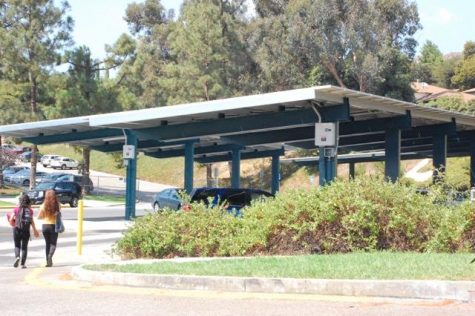Solar panels save money and environment
 (April 2, 2013) — 157,000 pounds. The amount of carbon dioxide that Clark has offset since installing the “cool” looking photovoltaic (PV), or solar, if you will, panels on the campus, according to a recent article in the Glendale News-Press .
(April 2, 2013) — 157,000 pounds. The amount of carbon dioxide that Clark has offset since installing the “cool” looking photovoltaic (PV), or solar, if you will, panels on the campus, according to a recent article in the Glendale News-Press .
For those who do not know, that is a lot of carbon dioxide, considering the fact that one gallon of gas in your car will excrete about 25 pounds of carbon dioxide into our atmosphere. Though it may not seem like it, those “shiny” looking futuristic contraptions that we see driving to the school every day are actually useful, and don’t hold the sole purpose being aesthetic.
“Green energy is the key to the future,” said junior Artem Bojadzian. “The continuous burning of coal and fossil fuels continues to not only hurt us, but also the environment.” “Of course I think they’re benefitting our school,” said freshman Shant Bekverdyan. “We get electricity from them and we don’t have to buy electricity again.” Though it may be true that the school is getting electricity from the panels, this doesn’t mean that the school district won’t have to “buy electricity” from the city anymore.
According to the GUSD, an estimated 62 percent of the energy the school uses will be provided by solar panels, leading to an annual savings of $65,648 off the school’s electricity bill. Although the numbers sound good, these estimates have not come to fruition thus far. Although the PV panels serve as a considerable source of energy, the school will still need to purchase 38 percent of the electricity it uses, assuming the estimate to be correct.
On top of that, data provided by SolarCity, the company which has installed the PV panels for many schools in GUSD, has shown that the total output of energy lacks in comparison to the District’s estimates. The only intervals where Clark’s PV panels actually produce more than enough power to equal the school’s daily consumption rate is on the weekends or holidays, days where the school is mostly shut down.
This lesser amount of energy can be due to the current season where there is less sunlight or due to the angle at which the sun’s rays hit the PV panels. Nevertheless, the total output of the solar panels has fallen short of reaching the total consumption of energy at Clark. So unless further changes are made, the efficiency of the PV panels may fall short of the District’s estimates.
“We will get our money back, but it’s probably not going to be in my lifetime and probably not in your life time either,” said Randy Tiffany, Clark’s school-to-career facilitator. “Yet despite the costs, I would encourage all schools to get them. I think they would save a lot of money. I guess over 30 years it’ll be worth it.”



